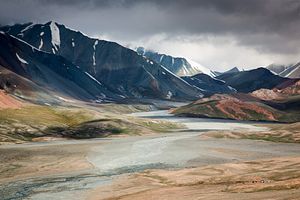Readers of The Diplomat may often wonder about the exact definitions of some of the regions covered here, such as Central Asia, South Asia, and exactly how far the Middle East extends into Asia. Indeed, this problem is related to the fact that the notions and boundaries of regions are constructs. Yet, several regions, like Europe, East Asia, and even South Asia have clear cultural and geographic boundaries are can quite reasonably be considered distinct units.
It is the definition of the region in between the aforementioned areas that primarily interests me. Much of this area is characterized as being part of the Islamic World and is at present usually considered a part of the current definition of Central Asia — the five former Soviet “stans” — and the Middle East, and perhaps the northwestern parts of South Asia. The division of this region into its present day categorization scheme does not accurately reflect the historical, geographic, and cultural connections and divisions of this area.
Instead, I propose a new way of dividing up and categorizing Central Asia and the Middle East on the basis of a historical and cultural approach. This definition, in fact, reflects the approach of The Diplomat, which uses an expanded version of Central Asia, or the crossroads of Asia, that is more in line with traditional Islamic geography. This region was shaped more than anything by being a nexus of overland “roads and routes” between other regions and by a culture that is overwhelmingly Persian (or Iranian) and Turkic in basis — not Arab, Indic, Russian, or Chinese.
The esteemed Middle East historian Albert Hourani wrote that the traditional Islamic world could be divided into “three broad areas.” One was the Maghreb, or the western part of this world; another was the central, coastal region comprising of the Levant, Egypt, and Arabia. Finally, the third region, that which concerns us most, consisted of Iran (as traditionally defined to include much of Afghanistan up to the Oxus and the Caucasus Mountains), southern Iraq, and the lands beyond the Oxus (Amu Darya river). This entire area was one cultural and geographic unit — understanding this helps our understanding of present day Iran’s area of influence.
Geographically, this area can be defined to be the area between the Tigris River, the Caucasus Mountains, the Persian Gulf, the Hindu Kush Mountains, the Tian Shan Mountains, and the Kazakh steppe. An expanded definition could include Anatolia and Xinjiang, though other arguments can be made for those regions. This definition checks out both geographically and culturally, in other words. Within this sphere, Persian (and later Turkic languages), and not Arabic, was the lingua franca and the language of literature. Whether Sunni or Shia, this separate ethnic and linguistic milieu gave it a distinct identity from Egypt and the Levant. To this day, a definition of the Middle East that includes Iraq, Iran, and possibly Turkey seems strange because it cuts them off from their more natural geographic and cultural neighbors in inner Asia.
As for South Asia, I would argue that it includes most but not all of Afghanistan, extending to the Hindu Kush Mountains that cut through the center of that country, from the northeast to the southwest. North and west of the mountains in Afghanistan, the Persian influence dominates, but south of them, Hindu-Buddhist culture was more predominant until the coming of Islam; even after the Pashtun in this area became Muslim, they have been tied much more firmly to South Asia, where many Pashtun dynasties ruled (and despite the fact that Pashto is an Iranian language). For these reasons, Afghanistan is usually classified as South Asia, though I would argue that it is split between regions and cannot be separated from the former Soviet states and Iran.
As for our region of discussion, there are many names for it. We can continue to call it Central Asia under an expanded definition or something else so as to avoid confusion with an area that has specifically become associated with the former Soviet states. Inner Asia, the Middle Word, or the Crossroads of Asia all work, though my preference would be to bring back an ancient term that has since fallen out of use for this area: Khorasan [Ed. note: this term may already be coming back.] While this region was formerly prosperous and intellectually developed, the last few hundred years have seen a decline in its economy and culture; hopefully modern times will lead to a new era of prosperity and artistic achievement.

































